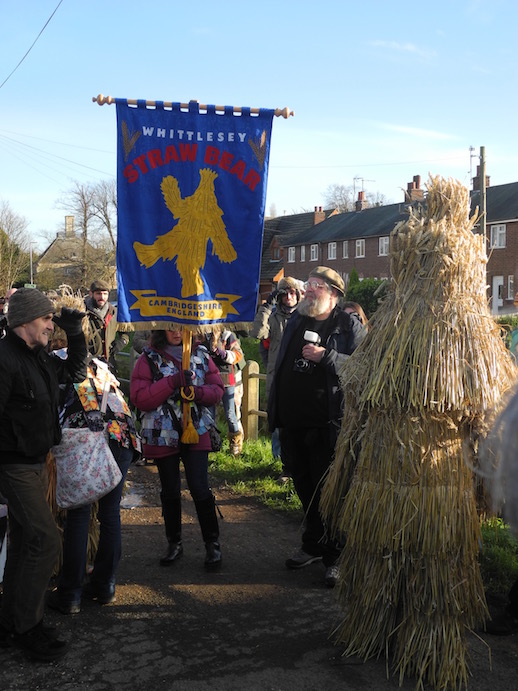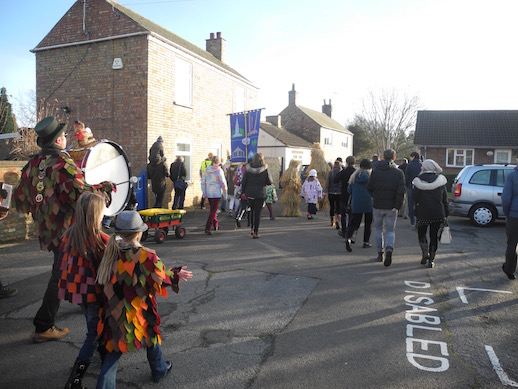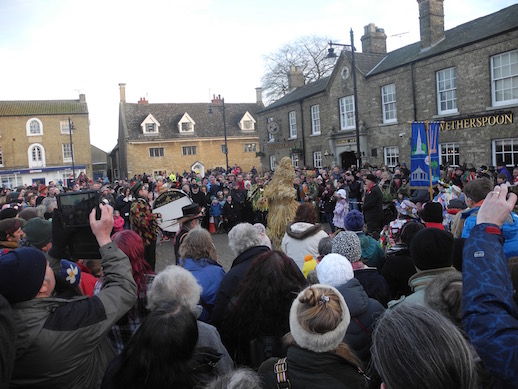Words: Luke Slater
Pictures: Sarah Campbell
The procession started a few minutes ago. It is 10:35 on a cold, bright January morning in the Cambridgeshire Fens. We stand on the kerbside with hordes of others, awaiting the arrival of the Straw Bear. The slow and jolly accordion droning of the Bear’s theme gets louder as the Bear approaches. Children and adults jostle for position around the streets of the Market Square. A man peddling helium-filled children’s balloons temporarily obscures the view. All eyes are fixed on the Bear as it dances down the street, clad head to toe in a suit of tightly-wound straw. Tended to by a bowler-hatted keeper, it is followed by a child-sized version, which dances with a little less agility and vigour.
This is Whittlesey (or Whittlesea) on Straw Bear Saturday, where an odd agricultural tradition that dates back to God-knows-when is embraced on an impressive scale. Historically, the Straw Bear would parade around town on the Tuesday after Plough Monday, dancing for money. The custom dwindled in the early 20th century for uncertain reasons. According to G.C Moore Smith in Folklore in 1909:
“I was told that two years ago a zealous inspector of police had forbidden ‘straw bears’ as a form of cadging. It seems a great pity that primitive customs should be suppressed by Bumbledom.”
Though the Straw Bear was present in 1909, the tradition faded away shortly after. In 1980 it was reintroduced by The Whittlesea Society, free of Bumbledom. 37 years on, it it now an extraordinary occasion where people of all ages line the streets in their hundreds, if not thousands. I heard someone accurately describe the day as like Christmas for Whittlesey. Shop windows are adorned with replica Bears and lampposts and bins are permanently decorated with straw motifs. The alcohol ban is lifted and plenty use personalised tankards to sip – or gulp – their ales. As well as the great crowds, there is a convivial atmosphere from early on. It is not a stretch to say that Whittlesey is rather proud of this rekindled custom.
Back at the parade, and following the Bear’s straw-strewn path are a number of fantastically and colourfully-dressed Morris dancers from across the country. Some carry sticks, some bear brooms and others bash their red clogs on the dark road surface. A blue painted plough adorned with assorted vegetables is dragged slowly by a handful of young men. Alongside the Bear’s grand tour, the dancing seems omnipresent, carrying on till dusk. After the initial procession, the Morris “sides” disperse, occupying spaces outside pubs, on street corners and, remarkably, in front of the pews and along the aisles of St Mary’s Church. Red Leicester, Midwinter Mummers, Gog Magog Molly, Witchmen Border Morris and Tyler’s Men are just a handful of the more intriguingly-named. The latter claim to practice an amusing “post-modern, deconstructed” form of Border Morris, but their border is the one between Lewisham and Deptford.
Earlier in the day, after a search for long-gone residences of long-gone ancestors, we investigated some of the partaking pubs and clubs. Which is all of them, of course. The Ivy Leaf Club now stands where my grandmother spent the first couple of years of her life. An unusual sight greeted our cautious entry: black-clad and black-faced Morris men and women sitting stoically either side of a rectangular table. A witch-faced woman exits the ladies whilst three normally attired ale aficionados gratefully discover that the bar is open before 10AM. As we leave, we see a giant plastic badger head resting on a car bonnet in the sunshine. By lunchtime we think nothing of coming face-to-face with a six-foot chicken smoking a pipe. It seems impossible to detach the festival’s spectacle with its fundamental absurdity. Why would you want to?
By mid-afternoon the procession becomes more informal, and anyone can join in. We find the bear – an easy task with the surrounding din – and enter the parade. It is a struggle for us to walk in time, clearly forgetting that a man who has spent the day prancing around in a five-stone straw suit walks at a more leisurely pace come 2PM. The procession has lost some of its former grandeur as it enters the far end of town. The streets and alleys become narrower, the dancers are elsewhere and many, I presume, are in one of the generous provision of Whittlesey’s pubs. But on the Bear goes, arms and legs gaily flailing. Children perch on windowsills with their parents and look out with amused and puzzled expressions. If this is Christmas Day, then at least they have a chance to see the Straw Bear in the flesh.
A short while after, we return to the markedly now more lively Market Square. The crowd has swollen in anticipation of the finale but dancing continues on the fringes. The Bear emerges for one last hurrah before its ultimate procession to the Leisure Centre, where it disappears, walking backwards and ducking awkwardly through the automatic entry doors, an uneasy marriage of age-old rural customs and modern architecture. It is not the end for the Bear, though. The suit will be ritualistically burnt tomorrow afternoon at the local school. Until then, the festival continues apace. Come evening people either leave or head into the pubs to enthusiastically carry on the merriment. Perhaps Whittlesey becomes a bleaker and sadder place on the 364 days when the town doesn’t dance to the Straw Bear’s tune. Given all I saw today, I’m reluctant to find out.
Luke Slater is a Bedfordshire-bred, London-based writer, music journalist, stout enthusiast and darts tragic. http://lukeslater.co.uk


